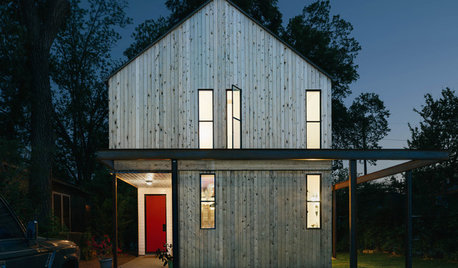I received the following questions via e-mail and decided to post the answer here so everyone who is knowledgeable about these plants can respond too. So, y'all, I'm counting on the rest of you to respond, esp. if you're in the OKC area, because I am far, far south and cannot speak to which plants do well there. Here's the questions:
"I live in OKC and we are wanting to grow a dense, thick evergreen fence/screen. What do you think about yaupons--fast or slow growing and do you think they will get dense? What about the height? Can't find burfordi standard--just dwarf. What are your thoughts on Thuja's? Emerald or giant....we have full sun but will need to also grow under a very large and old Elm Tree. Can you advise?"
First of all, my location in extreme southern Oklahoma is slightly warmer than yours in OKC in winter, although technically the same zone. In addition, I rarely have the ice storm problems that y'all have had there in recent years. So, I hope any OKC gardeners will advise you there if they feel like my advice is somewhat skewed by my slightly warmer winter temperatures or my slightly more alkaline soil. (For what it is worth, my highly amended soil has a pH of about 6.8 to 7.2 but my unamended native soil is quite a bit more alkaline. My water has a pH of 8.2. I don't know about the pH of soil and water in OKC.)
I do love hollies. They are a large and diverse family of shrubs and trees and there is a holly ideal for almost any location in Oklahoma, although perhaps not extreme western Oklahoma. In the holly family, yaupon hollies are among the best landscape plants available.
Yaupon Holly is Ilex vomitoria and it is native all the way from Long Island, New York to Chiapas, Mexico and at many places in between, but primarily in the southereastern USA, including in the very southeastern corner of Oklahoma. It is widely adapted, though, and is grown in many other parts of the country where it is not native. Some people grow yaupon holly successfully in zone 6 if they have a warm protected area or microclimate in their landscape.
One caution about yaupon holly is that its' berries can induce vomiting (hence its name) if ingested by humans or some other mammals, so be careful if you are planting it around small children. (Honestly, though, I think the taste of the berries would keep a child from eating more than 1 berry, and don't think one berry would be enough to make a child sick!)
Yaupon hollies, if allowed to take their natural shape, will achieve their tall, full vase-shaped growth in 10 years, or even less if you start with larger plants. Closer spacing will give you a dense hedge and you may shear or prune it to maintain a formal hedge. Honestly, though, I prefer to let them reach their natural shape and I don't prune them.
Yaupon holly will reach a height of 15' to 25' if unpruned and a width of 15' to 20' over time. The best spacing is probably about 10' apart in an urban setting or up to 15' in a rural setting where more space is available. You can leave them completely unpruned and they will be lovely and low maintenance. If desired, though, they can be tightly pruned or sheared into formal hedges although that requires a bit of work to maintain. Or, you can grow them as an unsheared hedge and then, after several years of growth and height are achieved, you can prune them up (removing lower limbs) into a tree-form.
Yaupon hollies are EITHER male or female, so you need to decide which ones you want. And, to get berries, you need both OR, if you plant only female plants, you need to have male plants within a mile or so in order to get berries. To ensure you get females, purchase yaupons in summer or fall when berries will be present on the females (or, conversely, not present on the males). Or, alternately, look for females propagated by cuttings from established female plants.
The flowers are very small and fairly inconspicuous but bees love them. Therefore, if anyone in your family is highly allergic to bee stings, you probably should plant only the male shrubs.
The berries are usually red or orangey-red drupes that hold on the plants throughout most of the winter. The berries are very astringent so birds usually avoid them until late winter or early spring. By then, repeated cycles of freezing-thawing have softened up the berries, and in some cases may have caused fermentation to begin. At this point, the berries are more attractive to birds....and the birds are more desperate, having eaten all the sweeter berries already. In spring, you'll often see flocks of cedar waxings and other birds flocking to the hollies to consume the berries, and sometimes you'll see inebriated birds.
Yaupon hollies will grow in almost any soil, although they'll do best in well-drained loam to sandy loam that has a higher percentage of organic content in the soil. They will tolerate clay soil, but it is best to add some organic material (compost, pine bark fines, manure, humus, etc.) to the soil prior to planting. Once established, they can handle our dry summers with little if any irrigation. (It takes about 3 years for them to become that well-established.)
As far as Thujas........I don't grow them here, although I had them in Texas about 20 to 25 years ago. In Texas, the arborvitae shrubs I grew were healthy, fast-growing and quite beautiful. They had no disease or pest problems there. I know a lot of people in Oklahoma grow them especially in the northern half of the state.
Thuja "Green Giant" can be planted about 4' to 6' apart if you are looking for a hedge that will fill in very quickly. If you can afford to be more patient and wait several more years for the hedge to fill in, you can plant them about 6' to 8' apart or maybe even a little further apart. They should reach a mature height of 20' to 30' in full sun and in good soil and with good moisture. They will get about 6' wide, or perhaps up to 8'. Be sure to plant them at least 6' from a fence or building so they are not too crowded.
"Emerald Green" will reach a mature height around 14'to 16' so they will be a better choice if you are growing under power lines. Their spread is not quite as wide as "Green Giant", perhaps about 4'. They are not quite as drought-tolerant as "Green Giant" and will need a little more water.
If you need to prune any thuja, it is best to do so in the springtime right before new growth begins. If you have good soil with a decent amount of organic material (5% or higher), your thujas (and hollies too) should be able to derive all their nutrition from the soil. Otherwise, you still shouldn't have to fertilize the first year, but perhaps annually after that. If you mulch the ground underneath your hedge, and I definitely would do that, then the mulch will feed the soil as it decomposes and the soil will feed the plants. An excellent organic fertilizer for almost all evergreen shrubs is Espoma's "Holly-Tone".
Back at the beginning of my answer, I said that yaupon hollies are among the best landscape plants available, and they are. Hollies are my favorite family of shrubs and both the Burfords and Yaupons are my favorites of all the hollies. I do want to briefly address the issue of Dwarf Burford vs. Standard Burfords.
Back in the 1980s, when we and our contemporaries were young and starting out with our marriages, houses, and landscapes, a lot of people bought "Dwarf Burfords" which often were sold with tags advising they would get 4' to 8' tall and a couple of feet wide. What do we know now? To put it nicely, that was all a huge lie. Those so-called Dwarf Burfords quickly (in less than a decade) attained a minimal height of 8' to 10' and 4' to 5' wide and, after 20 years, I'd say they are closer to 15' to 20' tall and 6' wide or wider. So, stay away from the so-called Dwarf Burfords unless you actually want tree-sized shrubs. They are only about 5' shorter and slightly more narrow than regular Burfords. Having said that, I LOVE, LOVE, LOVE the Dwarf Burfords I planted here 7 or 8 years ago and recently planted some more. However I spaced them about 6' apart and wanted for them to get tall....I have a 2-story house and wanted tall shrubs near it, not short ones. If there is a TRUE dwarf burford, it is hard to find and many that are sold as a dwarf really are not dwarf.
A highly underrated evergreen shrub that I also planted here, in this case on the north and northeast side of the house, is Southern Wax Myrtle. It is a gorgeous shrub that easily gets as tall as Burford Holly although not quite as dense. It does have lovely berries (Bayberry candles in the olden days were made from the berries of Southern Wax Myrtles, although nowadays the scents of bayberry candles are artificial) and is fast growing, tolerates almost any soil, and is drought-tolerant once well-established. I'd say it is second to hollies on my personal list of favorite shrubs.
I am a little concerned about the shrubs that will be in the shade of the very large and old Elm Tree. I think that, if the lower limbs of the tree have been pruned up and are 15' to 20' above the ground, then any shrub that tolerates shade will do well there. However, if the lower limbs of that elm are closer to the ground, then hollies probably would do better in the shade than the thujas would. That is based on my experience in Texas, and if someone in Oklahoma has found thujas to grow equally well in shade, I hope they'll let us know here in this forum.
If you have a choice of planting your hedge now or in the spring, I think it would be of great benefit to you (and the shrubs) to plant in the fall. This gives your shrubs a lot longer to get well-established before they have to face next summer's heat and that is a huge plus! Remember to keep their soil MOIST, but not soaking wet, all winter long. Younger shrubs often die their first or second winter because their roots get TOO dry and dry roots suffer freeze damage more easily they moist roots.
I hope you'll let us know what you decide, and then come back and let us know in future years how the shrub hedge has worked out for you!
Finally, I linked a list of hollies from the Dirt Doctor's website for you. It is just a really handy list and shows the diversity that exists within the holly family. He does show dwarf burfords as smaller shrubs than I've found them to be though.
When I was a young adult gardener, Texas gardening guru Neil Sperry used to advise people over and over and over again to plant hollies instead of some of the other shrubs they wanted to plant. Although I GREATLY admired and respected Mr. Sperry (and, believe me, I still do--HE IS "THE MAN!"), I kind of thought he went overboard in praising the hollies (and I hate to admit that I once thought that). Now, more than 2 decades down the road, what do I think? As in all things, Neil Sperry was 110% correct. He was right. I was wrong in thinking he was going overboard in praising the hollies. I have learned my lessons well, from both Neil Sperry and Howard Garrett, and I think hollies are superb!
I apologize in advance for the length of this post. I know it is very long. And, for those of you who keep saying I ought to write a book (and I am saying the following tongue-in-cheek), I think I just did!
Good luck,
Dawn
Here is a link that might be useful: Holly List
















aliciagreen
Okiedawn OK Zone 7Original Author
Related Professionals
Windham Landscape Architects & Landscape Designers · Pelham Landscape Contractors · Fairview Landscape Contractors · Lynwood Landscape Contractors · Metairie Landscape Contractors · West Orange Landscape Contractors · Whittier Landscape Contractors · Palos Hills Landscape Contractors · Auburn Decks, Patios & Outdoor Enclosures · Carlisle Decks, Patios & Outdoor Enclosures · Framingham Decks, Patios & Outdoor Enclosures · Grafton Decks, Patios & Outdoor Enclosures · Highland Springs Decks, Patios & Outdoor Enclosures · North Myrtle Beach Decks, Patios & Outdoor Enclosures · Statesville Decks, Patios & Outdoor Enclosuresenjoyingnaturetx7b
enjoyingnaturetx7b
scottcalv
enjoyingnaturetx7b
User
enjoyingnaturetx7b
Okiedawn OK Zone 7Original Author
scottcalv
AmyinOwasso/zone 6b
enjoyingnaturetx7b
scottcalv
Okiedawn OK Zone 7Original Author
enjoyingnaturetx7b